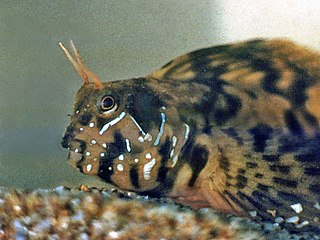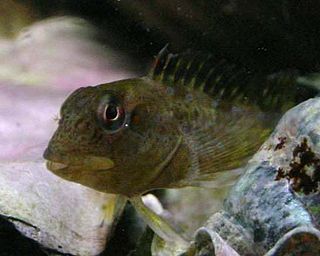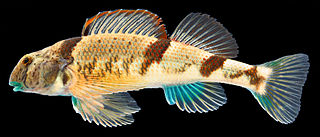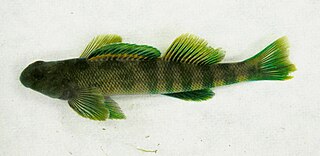Bass is a generic common name shared by many species of ray-finned fish from the large clade Percomorpha, mainly belonging to the orders Perciformes and Moroniformes, encompassing both freshwater and marine species. The word bass comes from Middle English bars, meaning "perch", despite that none of the commonly referred bass species belong to the perch family Percidae.

The viviparous eelpout, also known as the, viviparous blenny and European eelpout is species of marine ray-finned fish belonging to the family Zoarcidae, the eelpouts. It is notable for being ovoviviparous and gives birth to live larvae. It is a common soup ingredient in Mediterranean countries. The bones are of greenish colour, due to a harmless pigment. Their skin is slimy and the colour is variable.

Combtooth blennies are blenniiformids; percomorph marine fish of the family Blenniidae, part of the order Blenniiformes. They are the largest family of blennies with around 401 known species in 58 genera. Combtooth blennies are found in tropical and subtropical waters in the Atlantic, Pacific and Indian Oceans; some species are also found in brackish and even freshwater environments.

The butterfly blenny is a small marine blenniid fish of Northern and Western Europe, as well as the Mediterranean Sea and Black Sea and Morocco. It is usually found at a depth of 10–400 metres (33–1,312 ft) down, especially in areas with a rocky floor.

Salarias fasciatus, commonly known as the jewelled blenny or lawnmower blenny is a benthic, neritic, marine fish species endemic to Australasia. Despite being known as the lawnmower blenny, due to its propensity to consume algae growth in aquaria, it is principally a detritivore, with plant material making up only about 15% of its diet. The lawnmower blenny camoflauges with its surroundings, even changing color to hide itself from predators.

The molly miller is a species of marine ray-finned fish belonging to the family Blenniidae, the combtooth blennies. This species is found in the Atlantic, Mediterranean, and northwest Pacific Oceans. Its colour is a mottled tan, white, and black covering the body and fins. The head of this fish is covered with short hair-like appendages and has two very large eyes. This species reaches 12 cm (4.7 in) in total length.

The sphinx blenny is a species of combtooth blenny, and the only species in the genus Aidablennius. It was described by Achille Valenciennes in 1836, originally under the genus Blennius, and was later reassigned under "Aidablennius" by Gilbert Percy Whitley in 1947. It is a subtropical blenny known from Morocco, in the eastern Atlantic Ocean, and also from the Mediterranean and Black Seas. Sphinx blennies inhabit shallow, rocky waters in the littoral zone, with sunlight exposure. They feed primarily on benthic algae, weeds and invertebrates. Sphinx blennies can measure up to 8 centimetres (3.1 in) long in total length.
The jugular blenny is a combtooth blenny found in the western Indian Ocean. Klunzinger originally placed this species in the genus Blennius. It is a tropical, marine and freshwater blenny which is known from the Gulf of Aqaba and the Red Sea, in the western Indian Ocean. Male jugular blennies can reach a maximum standard length of 5 centimetres. The blennies are oviparous.

The leaping blenny, also known as the jumping blenny, is a species of combtooth blenny in the genus Alticus. There is some uncertainty as to whether it was first described by J.R. Forster in 1788 or B.G.E. Lacepède in 1800, although Fishbase currently accredits it to Forster. It was originally described as a member of the genus Blennius.

Lipophrys pholis, commonly known as shanny, also known as the smooth blenny or common blenny, is a species of combtooth blenny. It matures at two years of age. Distributed in the Eastern Atlantic from the southern Norway to Morocco and Madeira, including the Mediterranean and the Balearics. Lipophrys pholis feed primarily on crustaceans, but also feed on other invertebrates and plants.
Blennius normani is a species of combtooth blenny found in the eastern Atlantic ocean. It reaches a maximum length of 11 centimetres (4.3 in) SL. The specific name honours the British ichthyologist John Roxborough Norman (1898-1944) of the British Museum.

Montagu's blenny, also known as the capuchin blenny, is a species of combtooth blenny found in the intertidal zones of the eastern Atlantic ocean from England to Madeira and the Canary Islands as well the Mediterranean Sea, the Black Sea and the Sea of Marmara. This species prefers rocky shores with much wave action. This species grows to a length of 7.6 centimetres (3.0 in) SL. It is the only species in the genus Coryphoblennius.

Istiblennius is a genus of combtooth blennies found in the Pacific and Indian Oceans. The generic name is a compound noun composed of istio the Greek for "sail", referring to the high dorsal fin of the type species, Istiblennius muelleri, and blennius which is derived from a word for "mucus" and refers to the scaleless bodies that characterise the Blenniidae.

Lipophrys is a small genus of combtooth blennies found in Atlantic ocean and the Mediterranean Sea. It is one of 57 genera in the family Blenniidae. The generic name is made up of the Greek words lipo meaning "want" or "absence" and phrys meaning "eyebrow" referring to the lack of any cirri over the eyes in the type species L. pholis.

The blenny darter is a species of freshwater ray-finned fish, a darter from the subfamily Etheostomatinae, part of the family Percidae, which also contains the perches, ruffes and pikeperches. It is a poorly known species which occurs in Alabama and Tennessee where it inhabits swift riffles.

The greenside darter is a species of freshwater ray-finned fish, a darter from the subfamily Etheostomatinae, part of the family Percidae, which also contains the perches, ruffes and pikeperches. It inhabits swift riffles in the eastern United States and southern Ontario.
In the 10th edition of Systema Naturae, Carl Linnaeus described the Pisces as:
Always inhabiting the waters; are swift in their motion and voracious in their appetites. They breathe by means of gills, which are generally united by a bony arch; swim by means of radiate fins, and are mostly covered over with cartilaginous scales. Besides the parts they have in common with other animals, they are furnished with a nictitant membrane, and most of them with a swim-bladder, by the contraction or dilatation of which, they can raise or sink themselves in their element at pleasure.
Rhabdoblennius is a genus of combtooth blennies found in the Pacific Ocean, mostly in the western Pacific. The name of this genus is derived from the Greek word rhabdos meaning "stick" or "rod" and blennius meaning "mucus", referring to the absence of scales on the body of blennies.
Spaniblennius clandestinus is a species of combtooth blenny found in the eastern central Atlantic Ocean. It is known from a single specimen, the holotype, which was collected at Goree in Senegal
Desseria is a genus of parasitic alveolates belonging the phylum Apicomplexa. The genus was described in 1995. The species in this genus were previous considered to belong to the genus Haemogregarina.












